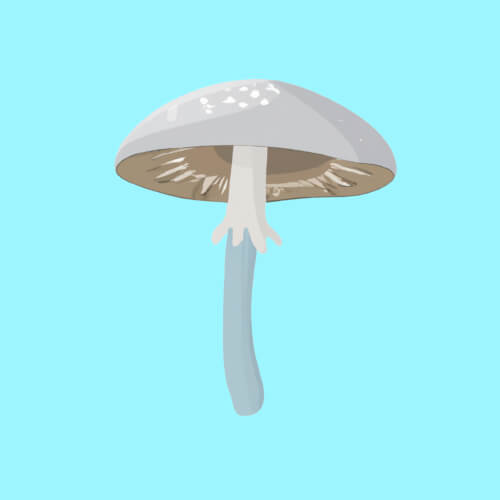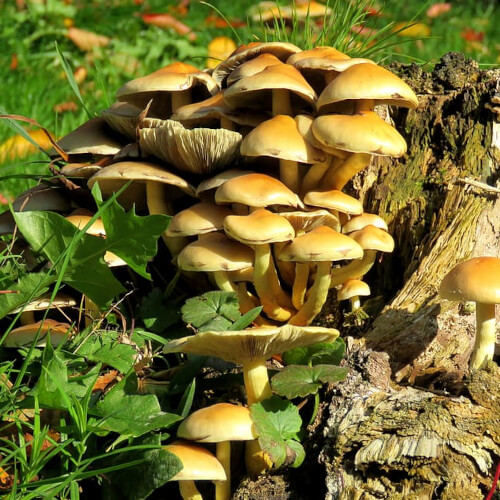



A mushroom, also sometimes called a toadstool, is the part of a fungus that produces and releases spores, special cells that can grow into a new fungus. Most mushrooms have a stem (stipe), cap (pileus), and gills (lamellae), but some fungi without stems are still said to have mushrooms.
Mushrooms can be found in diverse habitats all around the world. They can be spotted in forests, meadows, grasslands, and even in your own backyard! These fascinating fungi have the remarkable ability to thrive in different environments and ecosystems.
Many mushrooms prefer damp and dark places as their homes. They often grow in shaded areas, under fallen leaves, or near decaying logs and tree stumps. These locations provide the necessary moisture and organic matter that mushrooms need to grow.
Some mushrooms have specific habitat preferences. For example, certain species are commonly found growing in cooperative, or symbiotic, relationships with certain trees. These mushrooms, known as mycorrhizal mushrooms, establish mutually beneficial partnerships with trees. The mushrooms help the trees absorb nutrients from the soil, while the trees provide the mushrooms with sugars produced through photosynthesis.
Other mushrooms, known as saprophytic mushrooms, thrive on dead and decaying organic matter. They play a crucial role in the ecosystem by breaking down dead plants and trees, recycling nutrients back into the soil.
Mushrooms have significant importance in nature and for humans as well. In the natural world, they are essential for nutrient cycling and the decomposition of organic matter. They contribute to the balance of ecosystems by recycling nutrients and aiding in the growth of new plants and trees.
Humans have been fascinated by mushrooms for thousands of years. They have been used as a source of food, medicine, and even for artistic inspiration. Many cultures around the world have incorporated mushrooms into their traditional cuisines, creating delicious and unique dishes.
Some mushrooms have medicinal properties and are used in traditional medicine systems. They have been valued for their potential to support immune health, reduce inflammation, and provide various other health benefits. Scientific research continues to explore the therapeutic potential of mushrooms.
While mushrooms can be intriguing and exciting to discover, it's important to remember that not all mushrooms are safe to eat or touch. Some mushrooms can be poisonous and cause serious illness or even be deadly. It's extremely important to avoid eating and handling wild mushrooms unless with an adult who has proper knowledge and expertise.
If you are interested in learning more about mushrooms, consider joining nature walks or workshops led by experienced mycologists (scientists who study fungi). They can guide you in identifying different types of mushrooms and help you understand their characteristics and habitats.
The world's largest organism is a fungus called Armillaria ostoyae, also known as the honey mushroom. This amazing fungus grows underground and spreads out through a network of tiny threads called mycelium, kind of like the roots of a plant.
The mycelium network of the honey mushroom is estimated to cover an area of over 8.9 km2 in the Malheur National Forest in Oregon, USA. That's more than twice the size of the entirety of Central Park in NYC, which is only about 3.4 km2. The honey mushroom is also very old, estimated to be around 2,400 years old, making it one of the oldest living organisms on Earth.
While mushrooms might look like plants and also grow in soil, they are actually part of the fungi kingdom. In 1998 scientists discovered that fungi split from a common ancestor with animals about 1.538 billion years ago, whereas plants split from animals slightly earlier, at about 1.547 billion years ago.
So, just like how we are more closely related to our siblings than our distant cousins, the animal branch (including humans) is more closely related to the fungi branch than plants are related to fungi.
Scientists call this bioluminescence, or the ability of living things to create their own light. Some species of algae and corals also have a similar ability. The chemical that causes bioluminescence in some species of mushroom is called luciferin, and when it comes into contact with oxygen (O2), it creates energy in the form of light.
Scientists still aren't entirely sure why some mushrooms have evolved to produce light. It could be a way to attract insects that help to spread their spores, or it could be a way to scare away predators. Whatever the reason, it's a pretty cool and unusual ability that sets these mushrooms apart from others.
Mushrooms are around 92.5% water by mass. That means that if you fully dry 100 g of mushrooms, you'll only be left with 7.5 g. That's part of the reason dried mushrooms are so expensive!
This high water content is part of what makes mushrooms so unique. Unlike plants, mushrooms don't use sunlight to make energy. Instead, they get their energy from breaking down organic matter like dead plants and animals. Their high water content also means that they can quickly absorb nutrients and other substances from their environment.
It's true! This one specific county in Pennsylvania has the ideal growing conditions for mushrooms, including a moderate climate and rich soil.
Mushroom farming has been an important industry in Chester County for over 100 years. The county is home to many large-scale mushroom farms, some of which have been passed down through generations of families. The farms use advanced techniques, such as controlled environments and sophisticated ventilation systems, to produce high-quality mushrooms all year round.
After the mushrooms are harvested, they are sent to grocery stores and restaurants all over the country, and even exported to other parts of the world. So, the next time you eat a mushroom, there's a good chance it came from Chester County, Pennsylvania!